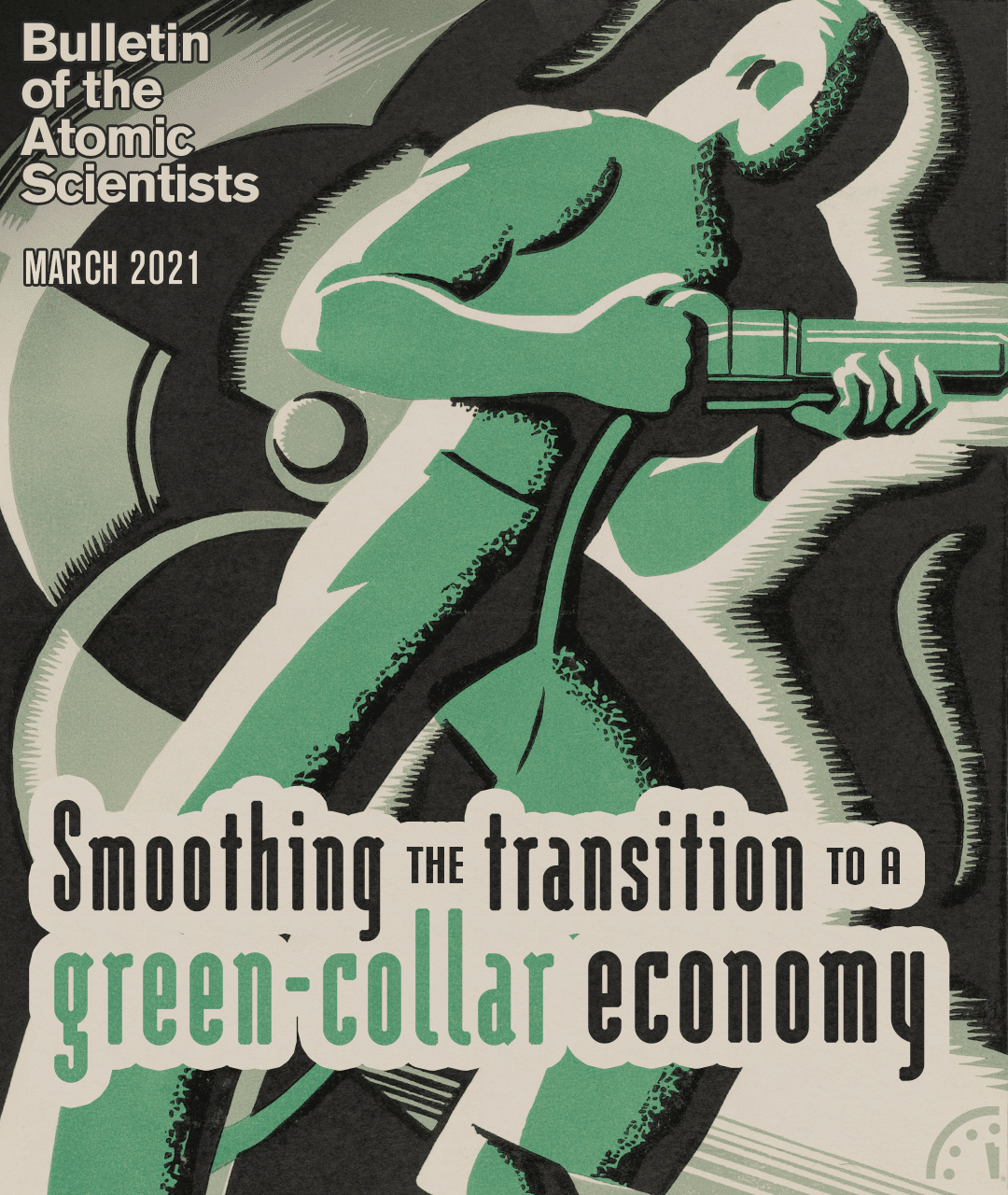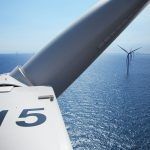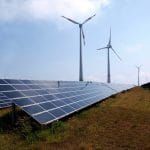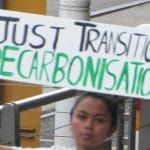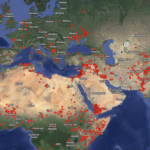A just transition for US workers is within reach
By Jason Walsh | March 15, 2021
A just transition for US workers is within reach
By Jason Walsh | March 15, 2021
Avoiding the worst impacts of climate change demands vigorous and immediate action. However, building a clean economy in the United States and the world requires that we adhere to an important principle: We cannot leave workers and communities behind as we make this transition.
Communities and workers affected by the ongoing energy transition will be hurt unless new public policy and investment is intentionally designed to support them. A “just” transition will not happen organically. Every major economic shift of the past several decades, from offshoring to “gigification,” has been manifestly unjust for American workers because elected policymakers have failed to craft a response that is fair and effective.
The BlueGreen Alliance unites labor unions and environmental groups in addressing environmental challenges like climate change, while at the same time advocating for policies that create and maintain high-quality jobs. Our “Solidarity for Climate Action” platform rebuts the false narrative that we have to choose between good-paying jobs and addressing the climate crisis (BlueGreen Alliance). Our platform puts working people front and center as we create a new, green economy. Any plan must respond to the climate crisis on the scale that science demands, while simultaneously addressing inequality in all its forms.
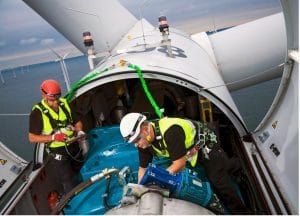
Working people should not suffer economically due to efforts to tackle climate change. The boldness of any plan requires that the workers and communities impacted are afforded a viable transition to accessible, high-quality jobs. Not enough of the new jobs that have been created or promised in the clean energy economy are family-sustaining jobs. We view unionization as key to ensuring that workplaces adhere to strong safety and environmental practices and that jobs pay well and have appropriate benefits.
Across energy-producing sectors, however, union density, wages, and benefits vary. As it stands, just four to six percent of workers in the wind and solar industry are unionized, a significantly lower rate than sectors in the fossil fuel industry (Barrett and Yudken 2019). And the wage gap between the wind and solar fields and other energy industries is substantial. For example, the average photovoltaic solar installer makes $46,850 per year, which is less than the average wages that construction workers in the nuclear industry earn ($77,820). The solutions to climate change can and must be solutions to the problems faced by American workers—including stagnating wages, runaway income inequality, and struggling communities.
Some leaders in the clean energy industry already see an opportunity to leverage the creation of jobs to ensure an equitable transition to clean energy. A recent agreement between the offshore wind energy giant Ørsted and North America’s Building Trades Unions recognized the fundamental fact that growing offshore wind in the United States was not only a way to generate clean energy but also a way to transition workers hit by the shift away from fossil fuels to other jobs (Ørsted 2020). “Our highly trained men and women professionals have the best craft skills in the world, and now will gain new experience in deep-water ocean work,” Sean McCarvey, the president of the building trades union, said recently.
The potential for responsible offshore wind development in the United States is substantial. According to the US Energy Department, if we used even one percent of the nation’s offshore wind capacity (Hartman 2016), we could power nearly 6.5 million homes; 2008 estimates put job creation potential off the Atlantic Coast alone at somewhere between 133,000 and 212,000 jobs per year (Pollin 2008). We have the technology to harness wind power off the coasts of at least half of our states, and the industry is rapidly expanding both domestically and internationally.
To fully capitalize on the economic benefits to US workers of offshore wind growth, we must ensure that the supply chain—from raw materials to components—is built domestically, and that the operations and maintenance jobs provide strong wages and benefits.
In working to achieve net zero emissions economy-wide by 2050—a goal supported by the Intergovernmental Panel on Climate Change that many countries are striving to reach—we must modernize and transform the entire US industrial base to make it the cleanest and most advanced in the world. This industrial transformation can bring dynamic industries back to communities that have been left behind by deindustrialization and under-investment; it can secure domestic supply chains while spurring the creation of a new generation of good, safe jobs manufacturing clean technology.
We need a plan
While we were forced to be reactive to dislocations in the coal industry, we must be proactive in other sectors of the economy. None is more important than manufacturing, where our metric of success should be no dislocations at all. Make no mistake: We have the ability to do this as a country. But we need political will and a plan.
In many cases, existing manufacturing facilities can be retooled for new purposes that align with emissions reductions. One good example of this is the US auto industry. Our research found more than 1,200 factories and engineering facilities in 48 states—and 288,000 American workers—already building vehicle technologies that reduce pollution and improve fuel economy (BlueGreen Alliance 2017).
With the size of the US market for electric vehicles growing (McDonald 2020), so grows the opportunity to secure and create good jobs manufacturing the components needed for these and other advanced, fuel-efficient vehicles. Capturing those jobs by increasing the amount of domestic content in electric vehicles, and growing our nation’s electric vehicle manufacturing capacit,y are vital to ensuring America’s auto sector does not fall behind the rest of the world in the race to build the current and future generations of vehicles.
We can drive the needed manufacturing innovation with smart procurement standards like “Buy Clean”—which ensures that the products we use in infrastructure and other investments are made in the cleanest possible ways, and that the federal government considers the carbon footprint of goods it purchases, while prioritizing manufacturing firms that uphold strong labor standards and create good jobs in low-income communities.
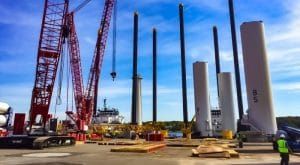
Robust infrastructure investment is another way to ensure that workers and communities in the fossil fuel industry have access to quality jobs. Investing now to repair our failing roads and bridges, water systems, and natural gas distribution pipelines, as well as to modernize our buildings and electric grid, transform our transportation systems, and support our urban and rural communities, will boost our economy and create millions of jobs, while also reducing pollution and combating climate change—paving the pathway to a strong and equitable recovery.
The benefits of investing in our infrastructure are massive. Investing an estimated $2.2 trillion in key sectors has the potential to support or create an additional 14.5 million job-years across the US economy and add a cumulative $1.66 trillion to gross domestic product over 10 years, reduce greenhouse gas pollution, and boost climate resilience versus a business as-usual approach (Barrett 2019).
Any plan that ensures a just transition must have good-paying union jobs at its core. To accomplish that, all public investments should be coupled with high labor standards and robust Buy American standards to ensure that the investments support domestic manufacturing.
Finally, for generations, coal-dependent areas—reliant on coal mining or coal-based electric power generation plants—have built their economies around coal, not only for the employment of their citizens, but for the revenue that supports their schools, infrastructure, and small businesses. In addition to maximizing the gains for workers as we deploy renewable and energy efficiency technologies, we need targeted responses that minimize the pain for workers and communities that have relied economically on technologies on the losing end of market demand. The National Economic Transition Platform—a plan crafted by local, tribal, and labor leaders, as well as national organizations like the BlueGreen Alliance—offers a blueprint on how to build resilient and equitable economies in the places hardest hit by the power sector’s move away from coal to cheaper and cleaner energy sources (National Economic Transition Platform 2020). The platform’s recommendations include:
- Investment in local leaders and long-term economic development planning in communities impacted by changes in our energy systems.
- Expanding investments in entrepreneurship and small-businesses to help communities diversify and strengthen their economies.
- Providing a bridge of support for workers and direct pathways to quality in-demand, family-sustaining jobs.
- The reclamation and remediation of coal sites to create jobs while cleaning up the environment.
- Addressing the impact of company bankruptcies on workers, communities, and the environment.
- Providing direct, coordinated access to federal programs to ensure communities can get the resources they need.
And, the mines and facilities themselves can provide an opportunity for economic diversification. Some examples:
In Mingo County, West Virginia, a sustainable agriculture facility is being constructed on a reclaimed coal mine; it will produce commercial-scale fish and vegetables for regional markets;
Reclamation of an abandoned coal mine that had been leaking pollution into the north branch of the Potomac River for decades in western Maryland paved the way for at least 13 commercial angling and whitewater boating outfitters to operate on the river, supporting more than 40 full-time jobs and resulting in an economic impact of nearly $3 million in the area,
In Glenrock, West Virginia, a surface coal mine was converted into a 158-turbine wind farm that produces enough electricity to power 66,800 households.
And in Luzerne County, Pennsylvania, a business park was constructed on reclaimed mine land; it now employs over 4,500 people and is home to 39 companies, including Lowe’s, FedEx Ground, and Men’s Warehouse. While more industrial parks are not the economic solution for many rural communities, this example demonstrates that mine sites could be reclaimed for “brick and mortar” project applications like local businesses, job training facilities, and business incubators.
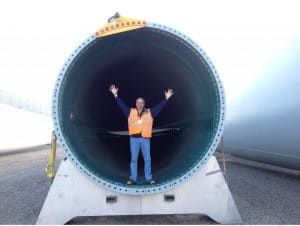
Manufacturing, infrastructure, environmental restoration, and clean energy are significant drivers of job creation and economic growth, but our investment won’t be effective unless we enact strong Buy American standards to ensure we make materials here in the United States, and labor protections that ensure government contractors pay employees prevailing wage, and government agencies award jobs to unionized contractors and to local workers.
Building a fair, clean, thriving economy means we cannot leave behind the workers and communities that have sustained our nation for generations. President Biden recognizes this in his clean energy jobs plan that focuses on creating high-quality, union jobs, while still fulfilling “our obligation to workers and communities who powered our industrial revolution and decades of economic growth.”
We share that vision of a just transition.
References
Barrett, J., Eckdish, J., Lipman, Z., and Johnson, R. “Making the Grade 2.0: Investing in America’s Infrastructure to Create High-Quality Jobs and Protect the Environment.” BlueGreen Alliance. https://www.bluegreenalliance.org/wp-content/uploads/2017/09/MakingTheGrade-2.pdf
Barrett, J., and Yudken, J. 2019. “The 2019 U.S. Energy & Employment Report.” National Association of State Energy Officials, and Energy Futures Initiative. https://static1.squarespace.com/static/5a98cf80ec4eb7c5cd928c61/t/5c7f3708fa0d6036d7120d8f/1551849054549/USEER+2019+US+Energy+Employment+Report.pdf
BlueGreen Alliance. No Date. “Solidarity for Climate Action.” Blue Green Alliance. https://www.bluegreenalliance.org/work-issue/solidarity-for-climate-action/
BlueGreen Alliance and Natural Resources Defense Council. 2017. “Supplying Ingenuity II: U.S. Suppliers of Key Clean Fuel-Efficient Vehicle Technologies.” BlueGreen Alliance, May 23. https://www.bluegreenalliance.org/resources/supplying-ingenuity-ii-u-s-suppliers-of-key-clean-fuel-efficient-vehicle-technologies/
Hartman, L. 2016. “Computing America’s Offshore Wind Energy Potential.” US Department of Energy, September 9. https://www.energy.gov/eere/articles/computing-america-s-offshore-wind-energy-potential
McDonald, L. 2020. “Forecast: 2021 US EV Sales To Increase 70 Percent Year Over Year.” CleanTechnica, October 30. https://cleantechnica.com/2020/10/30/forecast-2021-us-ev-sales-to-increase-70-year-over-year/
National Economic Transition Platform. 2020. National Economic Transition Platform. https://nationaleconomictransition.org/
Ørsted. 2020. “North America’s Building Trades Unions and Ørsted Sign Landmark MOU for U.S. Offshore Wind Workforce Transition.” PR Newswire, November 18. https://www.prnewswire.com/news-releases/north-americas-building-trades-unions-nabtu-and-orsted-sign-landmark-mou-for-us-offshore-wind-workforce-transition-301175446.html
Pollin, R., Garrett-Peltier, H., Heintz, J., and Scharber, H. 2008. “Green Recovery: A Program to Create Good Jobs and Start Building a Low-Carbon Economy.” September. Washington, DC: Center for American Progress. http://www.peri.umass.edu/fileadmin/pdf/other_publication_types/peri_report.pdf
Together, we make the world safer.
The Bulletin elevates expert voices above the noise. But as an independent nonprofit organization, our operations depend on the support of readers like you. Help us continue to deliver quality journalism that holds leaders accountable. Your support of our work at any level is important. In return, we promise our coverage will be understandable, influential, vigilant, solution-oriented, and fair-minded. Together we can make a difference.
Keywords: clean energy, climate change, climate crisis, electric vehicles, equity, global warming, manufacturing, union, workers
Topics: Climate Change

